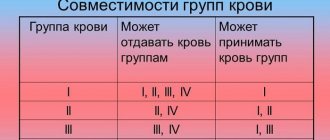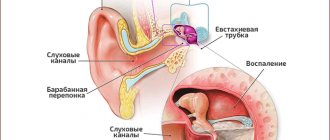66
Author of the article: Marina Dmitrievna
2017.10.08
57 413
Blood analysis
“Can a child have a different blood type?” – parents often ask. Let's deal with this in order.
Already in the nineteenth century, people knew about the existence of four groups. Scientists mixed different biomaterials and noted that the cells stuck together and formed clots. This indicated that the liquids that were mixed were somehow different from each other.
The birth of a baby is the main event in the life of every married couple.
Today people use the AB0 classification. Based on it, 4 types of blood are distinguished. It all depends on the presence and combination of certain substances (antigens and antibodies) in it:
- the first group does not contain antigens, so it is encrypted with the number 0;
- if protein A is present in the cells, this is the second;
- a third have B agglutinogen;
- and when agglutinogens A and B are combined, they speak of the fourth group.
The question often arises: can a child’s blood type differ from the parents’ blood? Yes, maybe we will consider this issue below.
In addition to antigens A and B, all people have a special protein D in their plasma and red blood cells; depending on its presence or absence, blood is divided into two categories. If this protein is present, then the person is Rh positive (Rh+); if it is not, the person is Rh negative (Rh-). This indicator does not affect health in any way.
How to determine a baby's blood type?
At conception, the DNA of the parents is combined, so the fetus receives certain characteristics, some from the mother, others from the father. Depending on which of the genes encoding a particular trait is dominant, the child exhibits certain traits. Therefore, the child's blood type often does not match the blood type of the parents.
When conception occurs, information about the composition of the internal environment of the parents’ body is transmitted to the fetus. He receives one of two genes from his mom and dad, which are then combined in a certain way. The child develops its own set of antigens.
Sometimes the blood composition of children and parents is the same. But there remains a high percentage of manifestations of other combinations, so the set of proteins on red blood cells will be different. The baby will inherit the same protein composition as its parents if they have the same set of antigens. But even such couples have children with a different combination of proteins, when the child’s blood type does not match the parents.
Possible and impossible combinations of inheritance
Possible blood combinations are calculated using special tables and diagrams. But this indicator can be accurately determined only after the birth of the child, when the doctor does a special analysis. During fertilization, the fetus receives a set of genes consisting of antigens from both parents.
Each group is determined by a combination of antigens, there are two types of them, therefore both mother and father have the following proteins:
- the first group does not have them, so it is designated by the numbers 00 (without antigens);
- if the cells have protein A, this is the second group;
- people of the third group are carriers of the B antigen;
- the fourth is AB, it combines both antigens.
To find out whether a child may have a different blood type than his parents, and what percentage of the combination of a particular set of proteins is, it is worth remembering what we were taught at school in biology lessons.
Pregnancy and a baby that is “alien” to the body
If a woman is Rh negative and a man is Rh positive, this does not mean that they will not be able to have a healthy child.
This is not a pathology or contraindication to pregnancy.
It’s just that the expectant mother should take a more responsible approach to planning pregnancy and bearing a child.
Monitor its development a little more carefully, for example, monitor changes in CTE, eat right and take vitamins.
If a child inherits the negative Rh of the mother, then the problem of sensitization will not arise at all, but in 50% of cases the fetus receives the Rh of the husband - the father, and then problems are possible.
The first pregnancy in such a situation most often proceeds well, because the mother’s body has not yet encountered positive blood cells, and protective antibodies are produced in small quantities.
The risk of Rh sensitization during subsequent pregnancies will increase each time.
To prevent pathologies, a pregnant woman with negative Rh should take blood tests more often than usual so that doctors can promptly notice the conflict.
A blood test must be taken:
- Monthly in the first trimester
- Twice a month in the second
- In the 3rd trimester - every week
If antibodies are not detected in the mother's blood, then the pregnancy proceeds normally. If there is such an indicator, doctors take measures: injection of special immunoglobulin and other procedures aimed at reducing the level of antibodies, and, if necessary, emergency delivery.
It is important to monitor not only the increase in antibody levels, but also its decrease. After all, if there were antibodies and then disappeared, then they could penetrate the fetus and be absorbed in it, harming the health of the unborn child.
The reasons that complicate the course of such a pregnancy are:
- Termination of previous pregnancies: surgical and spontaneous abortions, frozen pregnancies, miscarriages
- Surgical interventions
- Complications in previous pregnancies and births, especially related to bleeding
- Invasive fetal examinations
For example, premature placental abruption
Often, if antibodies are not detected before 28 weeks of pregnancy, doctors recommend a prophylactic injection of immunoglobulin , which is a specific “Rh vaccine” that binds the baby’s red blood cells entering the bloodstream of the expectant mother, preventing an immune response from appearing.
This injection is recommended after any reason that could cause biological sensitization.
During childbirth, a little of the newborn's blood enters the woman's blood system, which can trigger the production of antibodies.
Therefore, when a child’s Rh positive is established after birth, the mother is given a repeat dose of a special anti-Rh immunoglobulin to prevent conflict in the future.
Usually every maternity hospital has such a drug. But it is worth asking about its availability before giving birth, and if it is missing, then be sure to purchase it.
One of the most common modern pathologies of pregnancy. Fetal hypoxia: symptoms and consequences.
When can you get pregnant after taking antibiotics? How do they affect the fetus?
What did Mendel say about inheritance?
The scientist studied in detail the transmission of traits from parents to offspring. Based on research, he formulated the laws of genetics, in which he explained how traits appear in descendants. The laws he formulated are able to explain whether a child can have a blood type different from his parents.
Inheritance table according to Mendelian theory
The fetus receives one gene each from its mother and father, so it has the hereditary information of both parents. If it is the same, then it also manifests itself in the child. If different, then the trait that is dominant appears, and the second one is simply present - recessive. But it is capable of manifesting itself in the next generation.
By studying the mechanism of inheritance of the composition of red blood cells and plasma, scientists found that genes A and B are dominant, and gene 0 is recessive. Based on this, if A and B proteins are combined, they suppress the recessive gene, and agglutinogens A and B will be present in the child’s plasma, therefore, his group will be defined as the fourth (BA, AB).
Blood group combination
A child's blood type is inherited from his parents, but does it have to match? The answer is clear - no. It all depends on whether the parent has dominant genes and how they are combined at the time of conception. If they are carriers of the same proteins, the percentage that the baby will develop a different set of antigens is less. If the genes are different, the possibility that the fetus will have a completely different set of agglutinogens increases. Thus, we can only predict what composition will be passed on to children.
Many fathers and mothers wonder whether the child’s blood type can be different from the blood type that the parents have? After consulting with a doctor or studying certain literature, they understand that this is a completely normal phenomenon.
How is the Rh factor inherited?
If each family member is Rh positive, but the child was born without a certain protein, with Rh-, then the question immediately arises: can the child’s blood type and Rh factor differ from his parents? Against this background, situations even arise when the potential father doubts his participation in the birth of the baby.
Genetics are involved in determining this indicator. The dominant gene is D (Rh+) and the recessive gene is d (Rh-). A person who has the Rh substance may be a carrier of the recessive gene (Dd). A person with negative Rh will have a set of only dd (recessive genes).
Based on these data, we can predict whether this protein will appear in the baby. If both parents are Rh-, then the child will have the same genotype. After all, the parents are carriers of the recessive gene (dd), and there are no variants of the combination. If at least one of the partners has a dominant gene (D), then the child can be born with both positive and negative Rhesus.
There are cases when mother and fetus develop Rh conflict. In this case, the woman has (Rh-) and the child (Rh+). In this case, the mother’s body produces special antibodies that destroy the fetus’s red blood cells. This can be dangerous for the development of pregnancy. Although in some cases, the mother and doctors may not even know about this, since the pregnancy is proceeding normally, but they learn that the mother and child have a different Rh factor after birth.
This phenomenon can occur if the wife has (Rh-) and the husband (Rh+). Therefore, any pregnant woman should be under constant medical supervision. The consequence of Rh conflict between mother and fetus is hemolytic disease of the newborn, causing hypoxia, anemia, jaundice, and dropsy of the brain.
A blood test for Rh conflict during pregnancy is considered one of the important tests
If the first child in such a family was born with an Rh-positive factor, then in the future, during the pregnancy of the second and subsequent baby, the percentage of complications will increase.
But this is not a reason for concern and panic. Doctors are dealing with this issue. And if there is a threat of pregnancy, they will do everything possible to stabilize the woman’s condition so that she can carry and give birth to a child normally. To exclude complications, experts often recommend that couples take a blood test in advance, even before conception, in order to prepare for pregnancy.
Test: determining the sex of the unborn child based on the blood type and Rh factor of the parents
Wanting to find out the gender as quickly as possible, parents often resort to such “fortune telling”. It is impossible to find out the sex of a child based only on the blood data of the parents.
The table below contains statistical data.
If the results indicate a girl, this does not mean that it will be a girl.
This means: most people with these data had girls:
This table only determines the probability. After all, couples have several children of different sexes. And sometimes the facts completely contradict this table.
It is known that children of different sexes are born if they have a long period of time: more than five years.
An ultrasound examination at 20 weeks of pregnancy will help you find out what gender your first baby will be. Today this is the most accurate way.
For those who want to find out the gender of the baby, there is another table. The time frame of conception and the age of the mother are used here.
The principle of operation of this table has no scientific basis, but it is quite accurate.
Check your data: subtract 9 months from your date of birth, and remember the age of your mother at the time of your birth.
Important! Remember that even ultrasound data does not provide a 100% guarantee of the correct answer. Often, doctors' statements regarding the sex of the baby differ at different periods. We can only guess. It happens that throughout pregnancy a woman is assured that she is carrying a daughter, but a son is born. The table is not a carrier of reliable data at all.
Trying is not torture. Try all possible methods, study tables and other methods. Waiting for a joyful event is already happiness.
Whether it’s a boy or a girl is an exciting question, but the main thing is health. Choose names for both sexes, and wait for the second scheduled ultrasound, it will more accurately show what gender the baby is.
Don't be nervous about trifles, think positively. Previously, the sex of the child was found out only after birth. Please be patient.









